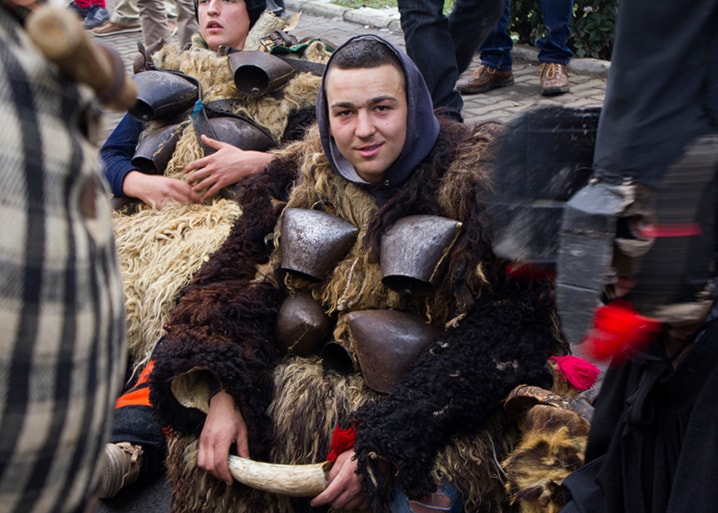Whether it’s a Bigfoot, Yeti or ogre, hulking and hairy Wild Men are the stuff of folk legends around the world.
Emily Hope discovered more about the history of these elusive mythical beings — and why they continue to fascinate us — by attending folk festivals during her five-week artistic residency in Romania in 2013.
The artist and photographer travelled to various town squares over the Christmas season and found modern-day Romanians dressed in the sheepskin costumes of medieval goatherds.
The anachronistic effect is recorded in photographs, drawings and prints in Hope’s multi-media exhibit, Ta, Ta, Ta! Caprita, Ta! (titled for a Romanian goat-themed song), showing at the Harris-Warke gallery in Red Deer.
Hope’s colourful photos show young people dressed as Muppet-like wild Greybeard characters. Besides hiding behind copious amounts of fake facial hair, they are sporting tassels, cow bells, horns and other accoutrements of a more superstitious time.
Greybeards, as well as Lady Death and assorted Draculi (devils), regularly appear in Romanian nativity plays. These pageants don’t sugar-coat the Christmas story, but mention King Herod’s Biblical Massacre of the Innocents along with the Wise Men, shepherds and angels visiting Baby Jesus.
On New Year’s Day, some Romanians dress as Brondosi — lolling tongued, long-eared carolling characters, who make noise to scare away evil spirits.
By combining ancient magical rituals with Christian themes, Romanians are keeping alive a quirky, localized offshoot of other European Wild Men traditions — from Greek satyr to northern Italy’s Schnappviecher (snapping beast), to French bear men, to Austria’s Wilder Mann.
“We can find evidence of the Wild Man going back to Gilgamesh,” she added, referring to an epic Mesopotamian poem considered the first example of world literature. It was carved into stone tablets from 2100 B.C.
Throughout history, the unbridled creature has played an integral role in festivals, storytelling, art making — even pop culture, considering The Hulk of comic book fame.
Hope added, “He is Puck, Harlequin, Old Saint Nick, and the devil himself. Here in Canada, we know him as Sasquatch.”
She mentioned other Canadian traditions involving unconventional behaviour and disguise — from Newfoundland’s house-crashing Mummers ritual to First Nations legends — even aspects of Halloween.
The Ontario-born artist, who lives in Kamloops, B.C., believes there’s a need to keep Wild Man rituals alive because people need licence to throw off their civilized fetters and misbehave for a while.
The legendary beings tend to be beastly, strong, oversexed and unrestrained. “Things that you can’t give expression to in proper society are applied to Wild Men,” said Hope, who holds a bachelors of fine arts degree from Thompson Rivers University in Kamloops.
Modern humans may have a need to believe that some beings remain unspoiled, unexplained and free.
While we are becoming more removed from the natural environment, which is exploited and threatened, Hope noted that Wild Men remain at one with nature.
Recent studies also found a correlation between a belief in the supernatural and more social and political unrest.
Hope believes the popularity of vampires, zombies, fairy tale characters and other mythical creatures has increased with high-profile incidents of global terrorism.
“When people are unsure about what’s going on in the world and they feel out of control, the supernatural pops up.”
Her Ta, Ta, Ta! Caprita, Ta! exhibit is on until Thursday, June 18, at the Harris-Warke gallery, upstairs at Sunworks on Ross St.
lmichelin@www.reddeeradvocate.com
